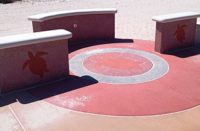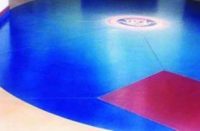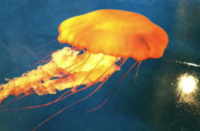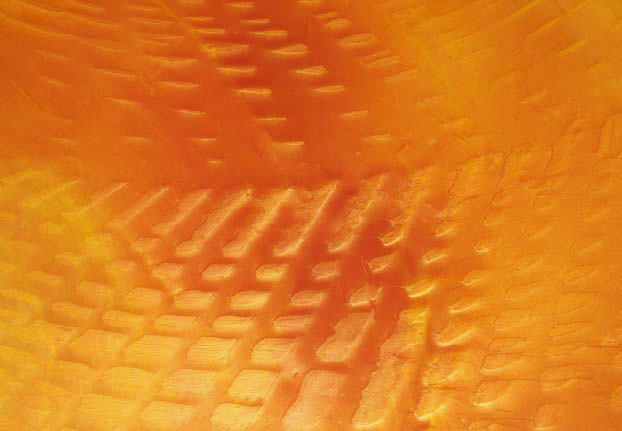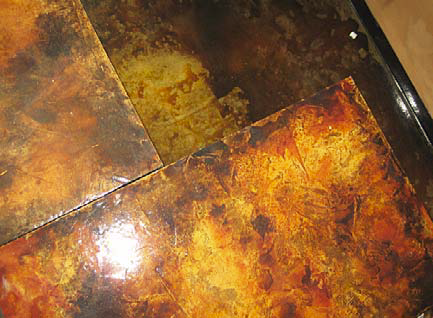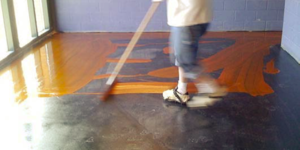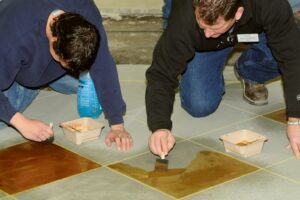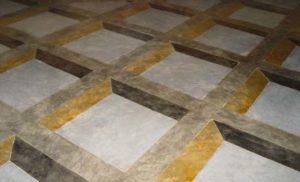Today’s contractors who love the look of acid stains but loathe the labor and time required to get the job done have more ways than ever before to bypass the troublesome application using safer-for-all water routes.
“The green movement has something to do with the growing popularity of water-based stains,” says Chris Sullivan, vice president of sales and marketing for Chemsystems Inc. “But the newer dyes and acrylics on the market are mainly becoming more popular because they are not as labor-intensive. They’re easier to apply, the prep goes way down and the hazardous issues go away. Overall, there are less problems to deal with and less callbacks.”
Sullivan estimates 30 to 40 percent of the labor and time are reduced when using water-based products to create acid-stainmimicking patterns. “The cost per square foot goes down substantially,” he says.
Here are a few water-based products that can do the trick:
Eco-Stain, from SureCrete Design Products, is a water-based, eco-friendly green product with zero VOCs that doesn’t require any cleanup after application. When dry, the surface just needs to be sealed.
Eco-Stain works off of concrete’s natural tendency to accept moisture, says Tony Leff, regional sales manager. “As it pulls in our product, it pulls in our pigments and gives the concrete that typical, mottled acid-stain look.”
Since no chemical reaction takes place, there is no extended wait time for the color to fully develop, no residue and no neutralizing afterward. Color may be built up without worrying about spending all a slab’s alkalinity. “It puts the applicator in control of the color instead of the concrete dictating what happens,” Leff says.
The line has 29 UV-stable colors that can be brushed, sponged or sprayed on interior and exterior surfaces. You can apply them wet on wet, mix or blend colors to create your own, or correct or enhance a color by applying wet on dry.
Leff says he doesn’t feel contractors need training to use the SureCrete product. “They just need an open mind to visualize the color schemes they want to create.”
Reflector Enhancer, from Elite Crete Systems, is a new product designed for contractors who are looking for something different. From a distance, the “enhanced” floor looks like a conventional acid stain or dye, but as you get closer the colors change and, ever so subtly, sparkle.
Engineered as a fine powder derived from an aluminum bismuth oxychloride, it can be added to waterbased clear sealers or specialty coatings as a subtle transparent color or as a variegated opaque finish. It is neither an oxide-based pigment nor a powdered dye.
“It’s so hard to get a good picture,” says Gene Dean, regional director of training and tech support for Elite Crete Systems. “Its shimmering and glimmering effect is pretty amazing. When you walk around and look at it, it’ll change color depending on how light refracts off of it.”
Reflector Enhancer, introduced in summer 2008, is currently available in 12 colors, with 10 more coming on the market shortly.
H&C Semi-Transparent Decorative Stain, from H&C Concrete Coatings, will soon be on the market. The nonreactive, environmentally friendly stain, which will be available in 24 standard colors, is designed to mimic acid stains. “It will debut by the end of the first quarter,” says Justin Brazie, product manager, “and will give contractors another option to make their installation easier.” He declines to release further details until the product is formally introduced.
Elements, from Butterfield Color, penetrates the surface, binds to the concrete and creates a mottled look, says sales manager Keith Boudart. “It’s used in place of acid stains where green products are requested or on older floors where the chemical reaction doesn’t produce the desired results,” he says.
The product, which is available in 16 standard colors, should be applied with a high-volume, low-pressure sprayer or an airless sprayer. Proper surface preparation is essential, and after the product is applied it must be sealed.
You can mix the product to create your own colors, he says. Elements can be used for interior and exterior surfaces, with the exception of red and purple, which can only be used inside.
Tintura, from L.M. Scofield Co.’s Lithochrome line, is a low-VOC acrylic and lithium silicate product for interior use that’s available in thousands of colors, including vivid reds, yellows, blues and even grays. The environmentally friendly waterborne stain, which has been on the market for about five years, penetrates and bonds with porous concrete or cementitious toppings for permanent, nonfading, predictable colors.
Tintura chemically bonds with cured concrete. The product contains a silicate that reacts with the calcium hydroxide (free lime) to produce calcium silica hydrate (CSH), which is the same material that forms when water is added to cement. CSH is the “glue” produced when cement hydrates.
“It can mottle or variegate depending on how you put it on,” says Scott Thome, director of product services for L.M. Scofield. To achieve a mottled effect, contractors should apply the material with an airless sprayer or a cup gun in a circular motion to create multiple thicknesses. Tintura is formulated to build more color with each additional layer. If the applicator applies it in a random motion, the varyingdepth layers will give the floor a variegated look from the same color.
For a multicolored acid-stain appearance, contractors should first apply a darker color, leaving voids in the pattern. Next, the voids should be filled in with a different color. Finally, the entire area should be coated with a lighter color, which blends the first two together and provides a common tone over the entire area.
Up to three coats may be applied to increase color intensity. The color treatment system can produce either a translucent or an opaque appearance.
Tintura needs to be finished with a compatible Scofield sealer, Thome notes.
